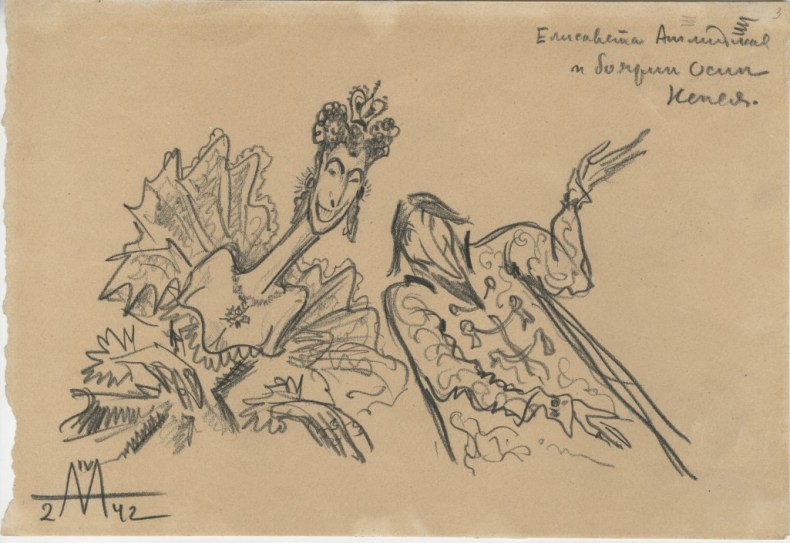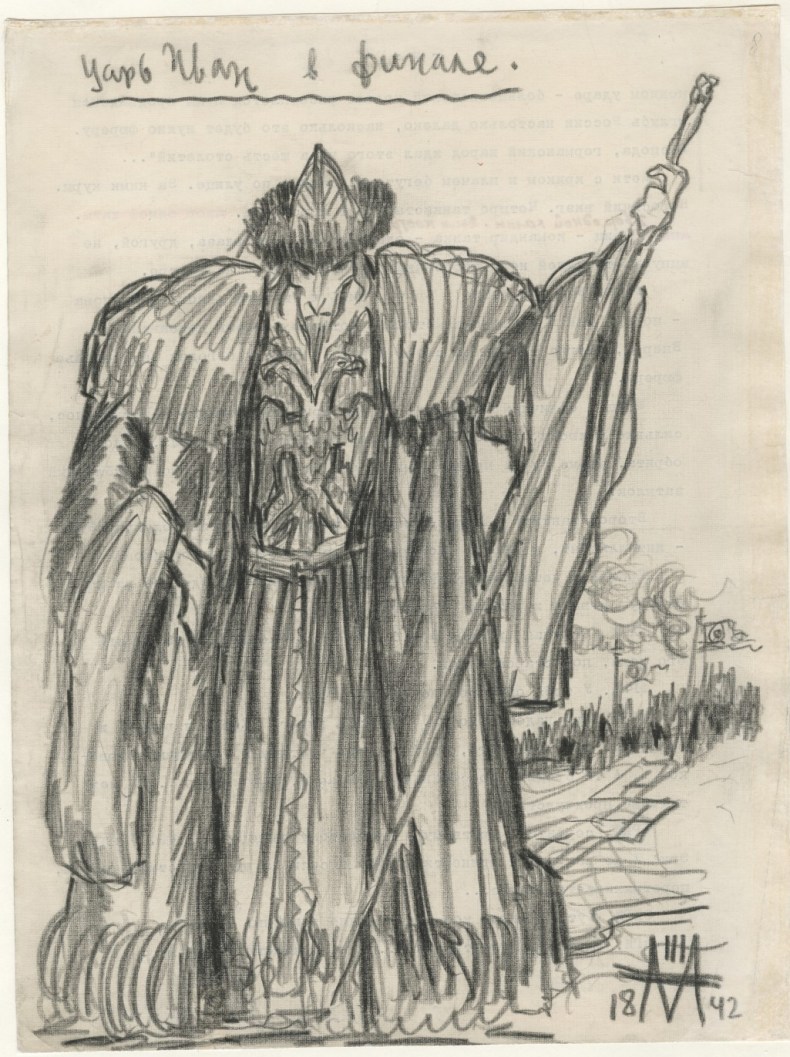Any attempt at a critical survey of Sergei Eisenstein’s oeuvre must be a mammoth, even insurmountable task, but a newly opened exhibition in London tackles this challenge with aplomb. Unexpected Eisenstein, presented by GRAD and Kino Klassika Foundation, presents 70 drawings for film and theatre by the director, and focuses on his relationship with England. These sketches are on loan from the A.A. Bakhrushin Central State Theatre Museum and the Russian State Archive of Literature and Art – some are grotesquely humorous, others admirably precise, despite being preliminary material for works that were later refined and completed. Revealing his lifelong interest in Shakespearean theatre and the novels of D.H. Lawrence and Arthur Conan Doyle, Eisenstein’s graphic pieces are testament to his propensity for crossing cultures and creating work that is universal and deeply personal all at once.
‘A lot is known about Eisenstein’s contributions to film and film theory, but we were interested in raising awareness of his drawings, which are relatively obscure in comparison,’ explains Elena Sudakova, director and principal curator at GRAD. ‘Some historians would argue that these drawings are meant to be studied the way one would examine a painting on an easel. But we’re against the idea of mounting them on the walls because that would probably have killed Eisenstein as a draughtsman. We want people to see him in the thick of his creative process.’ Lining the walls instead are photographs taken during Eisenstein’s only visit to the UK in 1929, an event that ignited both public and scholarly appreciation for Soviet revolutionary cinema. Prior to that, Battleship Potemkin (1925) and October: Ten Days That Shook the World (1928) had inspired only mild interest, although the former was notorious for being banned from public screening in many countries.

Preparatory drawing for Ivan the Terrible part III (unrealised), 1942, Sergei Eisenstein ©Russian State Archive of Literature and Art, Moscow
The curatorial strategy of spreading the sketches across a number of glass cases is one that works well: looking at the detail of Eisenstein’s preparatory drawings for the unrealised Ivan the Terrible Part III, one observes not just a gestural elegance in the way he wields the pencil, but also a charming smattering of scribbled lists and thoughts unrelated to the actual piece itself. The characters are shown in Elizabethan dress, perhaps demonstrating his intent to draw parallels between the political intrigue that defined the era and art produced under the Stalinist regime. The drawings can also be ‘read’ like pages from a diary, where the meaning of the narrative and the dynamics of Eisenstein’s own family life become fused together.
‘Stalin personally watched and gave his input on all of Eisenstein’s films before they were shown to the public. But Eisenstein had a very ambivalent relationship with the state: none of his films are simply political dramas meant to justify the brutalities of Stalinism. He was very interested in psychoanalysis, and it is possible to see how his interpretation of Ivan the Terrible also tapped on Oedipal undercurrents within his own family,’ Sudakova says. Large geometric figures dominate most of his earlier sketches, such as the costume designs for King Duncan in a production of Macbeth put up by the Central Education Theatre in Moscow. These belong to a creative lineage that can be traced back to the director Vsevolod Meyerhold, whom Eisenstein revered, and who theorised that characters should be portrayed in a way that faithfully reflected their places in the class system. Emulating this dramatic tradition, Eisenstein’s sketches depict the rich as being weighed down with clothing that is cumbersome to the point of caricature.

preparatory drawing for Ivan the Terrible, 1942, Sergei Eisenstein © Russian State Archive of Literature and Art, Moscow
One of the highlights of the exhibition is the curved block on which clips from Eisenstein’s films are juxtaposed against excerpts from English films inspired by his distinct style. The viewer is able to make a frame-by-frame comparison between the stylised battle scenes in Alexander Nevsky (1938) and Laurence Olivier’s Henry V (1944). The shape of the screen is also significant as it pays homage to Eisenstein’s vision of a spherical Gesamtkunstwerk amalgamating all the radically different ideas that fed into his practice. ‘Preparing for the exhibition and reading about his dream of creating a spherical book, we realised that it was almost as if he was describing the internet before it existed,’ Sudakova notes. ‘He sucked out the history of the world and recycled it and recreated it in infinite ways.’
Another gem of the show is a radio play from the BBC archives based on Alexander Nevsky, which visitors can listen to using headphones. Set to a febrile, surging Prokofiev score, it was performed on 8 December 1941, on the night of the Pearl Harbor bombings. Complementing the exhibition is an audio walk that takes the visitor beyond the confines of the gallery to re-enact Eisenstein’s experience in London. No doubt the protean mind of a figure as huge and complex as Eisenstein continues to elude exhaustive analysis, but this exhibition provides a fresh perspective on his legacy.
‘Unexpected Eisenstein’ is at the GRAD Gallery, London from 17 February to 30 April 2016, and is co-curated by Ian Christie and Elena Sudakova.














![Masterpiece [Re]discovery 2022. Photo: Ben Fisher Photography, courtesy of Masterpiece London](http://zephr.apollo-magazine.com/wp-content/uploads/2022/07/MPL2022_4263.jpg)
‘Like landscape, his objects seem to breathe’: Gordon Baldwin (1932–2025)